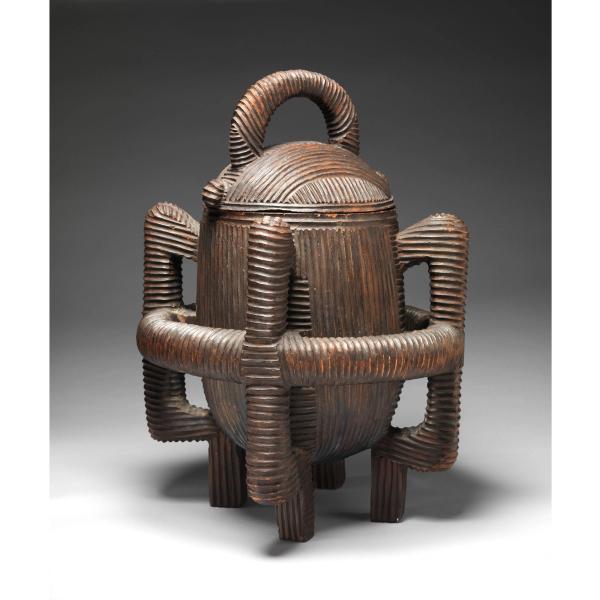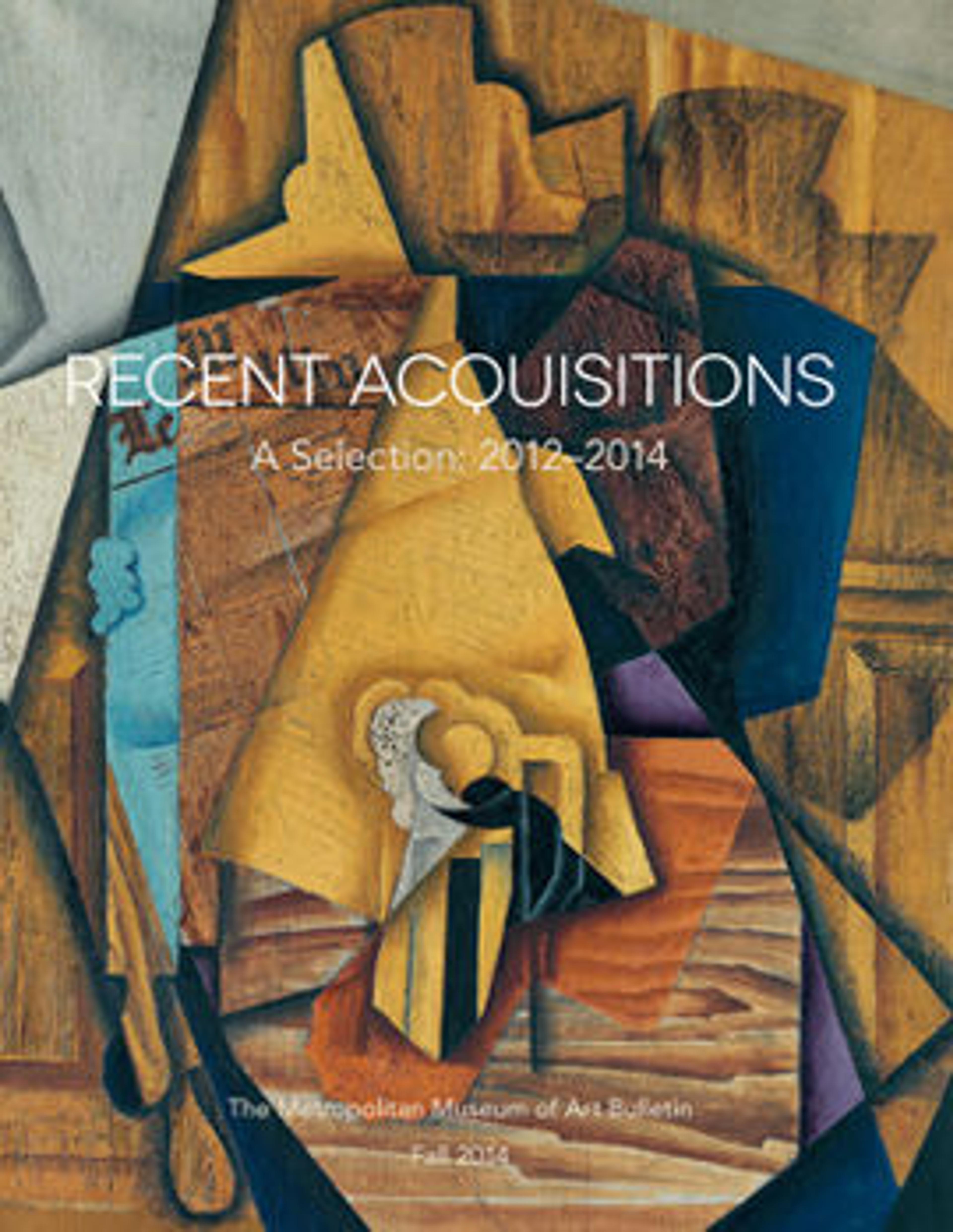Lidded prestige vessel
The vessel is one of the largest and most significant in a defined corpus of related sculptures that have been attributed to a number of Zulu-speaking carvers, active in the mid-nineteenth century in the vicinity of the former British colony of Natal, in present day Kwa-Zulu Natal, South Africa (Catherine Elliot, personal correspondence, 11/04/18). The headrest (2018.356) is also considered part of this group. These craftspeople were regionally renowned for their skill in wood carving, and the sculptor responsible for this work would have produced carvings both for a local elite, such as the Zulu King Mpande kaSenzangakhona (r.1840–1872), and for a European clientele, an increasing presence at Port Natal from the 1820s onwards. Major works of sculpture by this group were first exhibited in Europe at world fairs such as the International Exhibition, held in London in 1862, which intended to showcase the fine arts of all nations following the example of the Great Exhibition of 1851. Here, a number of Nguni sculptures were showcased in the ‘Natal Court’ (Elliott, Cartwright and Kevin, 2013: 18).
A contemporaneous inventory of the works on show was compiled by Dr. Robert James Mann (1817–1886). While Mann did not record the names of most of the sculptors, he did attribute an exceptional group of carved wooden objects to “a renowned artisan, named Unobadula” (Mann, 1862 Works by this artist included a chair “carved out of one block of wood”, a headrest, and “three pots”. Two of these pots were described as having “pedestals” or supportive superstructures—much like this example—and are currently housed in the British Museum (Af.4876 and Af.4875). A photograph taken by Mann of “the wood-carver Unobadula” shows him holding what appears to be a double tiered vessel mounted on a pedestal with a surface of parallel lines (Elliot, Cartwright and Kevin, 2013: fig.5).
About twelve large-scale covered vessels have been recorded in various museum collections. Alongside the examples in the British Museum, the Musée Quai Branly in Paris, the Cleveland Museum of Art, and the Natural History Museum in Lille all have important examples. In South Africa, the Brenthurst Collection at the Johannesburg Art Gallery features three important examples. It is unclear what they were used for. Early texts state that they were variously used for beer, known as “rhewu”, and also for milk and butter. According to Mann’s 1862 inventory: “Great potentates…have their beer brought to them in Wooden Pots.” He notes that because of the scale of the vessel, the drinker may have needed to have it lifted on his behalf (Mann cited in Elliot, Cartwright and Kevin, 2013: 19). Such vessels may also have functioned as large-scale tobacco or snuff containers, their monumental scale intended to impress visitors at court, where they might have been reserved for ceremonial occasions alone (Nettleton: 1996). The existence of a spoon with the example in Lille has been taken as an indication that these vessels may originally have been used for culinary purposes, such as containers for porridge.
Analysis of the interior surfaces of the wood, however, has found no residue of substances that the vessel might once have contained (Ellen Howe, personal communication, 08/04/13). Indeed, very few traces of wear or usage exist across the whole corpus (Klopper, personal communication with Alisa LaGamma, 04/08/13). This lack of evident use indicates that the vessel may always have been intended as a stand-alone work of art rather than a functional container. These were either used by local potentates as prestige items, or exhibited at international exhibitions.
James Green, Ph.D.
The Sylvan C. Coleman and Pam Coleman Memorial Fund Fellow, 2017–2018
Further Reading
Angas, George French. 1849. The kafirs illustrated in a series of drawings taken among the amaZulu, amaPondo and amaKosa tribes ; also, Portraits of the Hottentot, Malay, Fingo and other races inhabiting Southern Africa ; together with Sketches of landscape scenery in the Zulu country, Natal and the Cape colony. London: Hogarth Press.
Elliott, Catherine, Caroline Cartright and Philip Kevin, ‘Maker, material and method: reinstating an indigenously made chair from Kwa-Zulu Natal, South Africa’ Technical Research Bulletin, British Museum, Vol. 7, 2013: 15 – 30. (http://www.britishmuseum.org/pdf/BMTRB_7_Elliott_Cartwright_and_Kevin.pdf)
Elliott Weinberg, Catherine ‘The Name of Zulu is Now Given’: Provenancing Objects from Colonial Natal in the British Museum’s Christy Collection’ in Leibhammer, Nessa, and Carolyn Hamilton. 2016. Tribing and untribing the archive identity and the material record in Southern KwaZulu-Natal in the late independent and colonial periods Voume 2, pp. 475 – 502.
Mann, Robert James 1862. A descriptive catalogue of the Natal contribution to the International Exhibition of 1862.
Nettleton, Anitra ‘Lidded Vessel’, in Musée du quai Branly, Yves Le Fur, David Radinowicz, Susan Schneider, and Sarah Kane. 2009. Musée du quai Branly: the collection: art from Africa, Asia, Oceania, and the Americas. Paris: Flammarion, 102.
Nettleton, Anitra C. E. 1991. "Tradition, authenticity and tourist sculpture in 19th and 20th century South Africa". Art and Ambiguity: Perspectives on the Brenthurst Collection of Southern African Art. 32-47.
Nettleton, Anitra 2008. African Dream Machines: Style, Identity and Meaning of African Headrests. Johannesburg: Wits University Press.
Artwork Details
- Title: Lidded prestige vessel
- Artist: Circle of "Unobadula" (active mid–late 19th century, KwaZulu-Natal, South Africa)
- Date: Mid–late 19th century
- Geography: South Africa, KwaZulu-Natal
- Medium: Wood
- Dimensions: H. 24 13/16 × W. 17 × W. 17 in. (63 × 43.2 × 43.2 cm)
- Classification: Wood-Containers
- Credit Line: Purchase, Anonymous, Richard, Ann, John, and James Solomon Families Foundation, Adam Lindemann and Amalia Dayan, and Herbert and Lenore Schorr Gifts, Rogers Fund, and funds from various donors, 2013
- Object Number: 2013.165a, b
- Curatorial Department: The Michael C. Rockefeller Wing
Audio

1559. Lidded prestige vessel, Circle of “Unobadula”(?)
Nessa Leibhammer
NESSA LEIBHAMMER: The vessel has the feeling of being animate. It is as if it has its own personality. It has legs and arms. And it has a body. And it has the most satisfying sense of volume.
ANGELIQUE KIDJO (NARRATOR): This extraordinary sculpture was likely a prestige object for an elite member of the community or was produced for exhibition at an international art fair.
Here is Nessa Leibhammer—researcher, writer, and independent curator of South African art.
NESSA LEIBHAMMER: Of the approximately 40 carved large lidded wooden vessels with legs from 19th century KwaZulu-Natal that have been identified, only 10 have the distinctive surround structure as seen in The Met vessel. The vessel is exceptional—the skill that the carver would have needed to carve this object with the precision that he has out of a single block of wood. The dynamics of the grooving that animates the surface is executed with the most extraordinary skill. One would need to be conscious of the negative and positive spaces that play rhythmically around that vessel.
ANGELIQUE KIDJO: Unobadula is the only named artist identified with these types of vessels.
NESSA LEIBHAMMER: While we only have one name of a carver of this type of vessel, people did not operate in isolation. People traveled, they saw what other carvers were making, they visited and they would have shared ideas. So there may well have been a community of carvers who were producing objects of this type.
More Artwork
Research Resources
The Met provides unparalleled resources for research and welcomes an international community of students and scholars. The Met's Open Access API is where creators and researchers can connect to the The Met collection. Open Access data and public domain images are available for unrestricted commercial and noncommercial use without permission or fee.
To request images under copyright and other restrictions, please use this Image Request form.
Feedback
We continue to research and examine historical and cultural context for objects in The Met collection. If you have comments or questions about this object record, please contact us using the form below. The Museum looks forward to receiving your comments.
